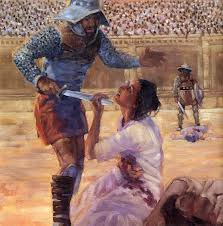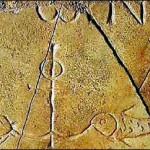[Here is a excerpted portion of the very recent RBL review of Candida Moss’s recent book on martyrdom by Clayton Croy, a fine NT scholar at a Lutheran Seminary in Ohio. Permission to post the excerpt was granted by the Society of Biblical Literature. See what you think. My view is that her book is revisionist history at its worst. BW3].
——-
Chapter 2 explores “Christian Borrowing of Jewish and Pagan Martyrdom Traditions.”
Early Christian martyr acts occasionally allude to the Maccabean martyrs and, more rarely, to the example of Socrates, but it is an error to assume, as Moss does, that the presence of intertextual echoes means that narratives ostensibly relating actual events are nothing but “highly stylized re-writings of earlier traditions” (56). Luke has indeed given
us a portrait of Jesus’ passion in which the central character is more resolute than in Mark. Whether this means that “Luke’s heavy-handed editorial work” constitutes over-writing the events with a non-Christian theology of noble death is another question (61). If Luke’s aim was to portray Jesus as a second Socrates, he could have made it a lot clearer. Moss similarly analyzes parallels between the Martyrdom of Polycarp and both canonical and classical accounts of death. She acknowledges similarities to Jesus’ passion but also finds Greco-Roman philosophical influences. Again, meager evidence is inflated
to conclude that “one of the most famous and important Christian martyrdom accounts was dependent on pagan martyrdom for its substance” (66). Other early Christian martyrs are likewise portrayed as “heroes of the classical world [who] were reshaped into soldiers for Christ” (79). Allusions to pagan models occasionally peek above the surface in martyr acts, but echoes of Jesus’ passion are far more numerous and more deliberate. Moss’s analysis lacks nuance and a sense of proportionality.
Chapter 3 picks up the language of the book’s subtitle: “Inventing Martyrs in Early Christianity.” Moss begins with the story of Chrysanthus and Daria, saints in the Catholic and Orthodox churches,a story that she characterizes as “romantic, exciting,interesting,and completely untrue” (85). Moss may be over-confident in her dismissal of the account (National Geographic aired a program in April 2011 describing the analysis of relics from the tomb of Chrysanthus and Daria that seemed to corroborate the basic fact of their death), but she raises an important issue thereby. The cult of the saints that began in the fourth century gave rise to a large body of hagiography, stories of venerated martyrs that often were of dubious historical value. Moss notes that later Protestants were critical of the cult, especially its traffic in relics and superstition. She helpfully describes the work of John Bolland and his students, who gave birth to critical hagiography (89–91). Without question, the corpus of martyr acts, especially those stemming from the Middle Ages,contains a mixture of history, legend, and piety. In the spirit of the “Bollandists,” Moss isolates the six authentic martyr accounts that remain from the church before 250 C.E.
She is emphatic that “these six accounts are as good as it is going to get” and that “if we cannot trust that these stories preserve the events precisely,then we cannot trust that any martyrdom stories do” (93). Moss is correct that these six accounts are generally judged to be the most reliable ones from the early period, but the implication that everything thereafter is legendary chaff is quite mistaken. Persecution from 250 to the early
fourth century was even more systematic and widespread, and it is often attested by contemporary or near-contemporary writers. The bulk of this chapter is devoted to a march through these six accounts, dissecting them
for every possible anachronism or inconsistency, real or perceived. The drift of the chapter is clear: even in these six stories we are on shaky ground. But Moss’s skepticism is often unwarranted. She says, for example, that “literary flourishes make it impossible for us to imagine that the
Martyrdom of Polycarp is a historical account of the events as they
actually happened” (100). But surely literary flourishes versus
historical information is a false dichotomy. The same is true for allusions to the Gospels, alleged anachronisms, and other peculiarities. Some of these are hardly as compelling as Moss thinks; others, even if valid, scarcely require us to dissolve the account into sheer fiction or a “pious fraud”
(104).
Moss earnestly argues that the Martyrdom of Polycarp was written in the third century (nearly everyone dates it to the 150s or 160s), but the chief merit of this dating is that it serves Moss’s thesis by removing the story further away from the events, thus undermining its historical value. In general, the issues that Moss raises in this chapter deserve consideration, but they do not necessarily compel her conclusion. She notes that “there is no early Christian account that has been preserved without emendation” and that “none of the early Christian martyrdom stories is completely historically accurate” (124). Even if one grants both of these claims, the result is by no means a thin residue of legend. Emended texts with occasional inaccuracies may still relate substantially historical events.
Chapter 4 takes up the basic question: “How Persecuted Were the Early Christians?” In contrast to the distorted picture of constant persecution that we get from Christian literature, art, and film, Moss asserts that “Christians were executed as the result of imperial initiatives” for fewer than ten years out of the nearly three hundred from Jesus to Constantine (129). Apart from the fact that someone would have to be omniscient to
make this claim authoritatively, the numbers Moss cites misrepresent the lived reality of Christians in the Roman Empire. As Paul Holloway warns, “scholars of early Christianity make a serious mistake when they focus on the ‘local and sporadic’ nature of early Christian persecution—as if tallying actual deaths allows one to somehow quantify the lived experience of lethal prejudice” (Coping with Prejudice, 36). The threat to Christians’ lives pervaded the first three centuries, with the exception perhaps of the latter part of the third century. Even when martyrdom was not being carried out, a
ll that stood between Christians and the executioner was the lack of a
delator (an accuser).
Chapter 4 first treats the persecution of Christians by the Jews. In a post-
Holocaust world,this is indeed an area to tread lightly, but Moss’s minimizing conclusion involves a peculiar word game. She claims that Jews did not persecute Christians in the first century because Christians did not yet exist: “Not only did the name ‘Christian’ not yet exist, but the idea of Christians as a group distinct from the rest of Judaism did not exist in the
lifetimes of the apostles” (133,emphasis original). The alleged non-existence of the name does not reckon seriously with Acts 11:26; 26:28 and 1 Pet.4:16, but more importantly, the fact that Jews might not have viewed Christianity as a religion distinct from Judaism is irrelevant. Persecution can take place
within a religious group. By Moss’s line of reasoning, Pharisees, Sadducees, and Essenes did not exist in the first century either!
More troubling in this chapter is the treatment of Roman sources: Tacitus and Pliny. Tacitus (Annals 15.44) records the famous incident of the Great Fire in Rome and Nero’s attempt to pin the blame on Christians. Because Tacitus wrote about fifty years after the events, and because Moss finds his use of “Christians” to be anachronistic, she asserts that Tacitus “does not provide evidence for their persecution” (139). There is simply no warrant for this kind of skepticism. The Great Fire, including Nero’s persecution of
Christians, is accepted by virtually all Roman historians. The persecution is partly corroborated by Suetonius (16.2) as well as 1 Clem.5–6. The difficulty that Nero poses for Moss’s “myth” is an early, large scale, lethal assault on Christians. Even if this was limited to Rome—which appears to be the case—
it set a precedent to which later emperors and governors could appeal.
Pliny is harder for Moss to dismiss,since he deals with contemporary issues in his own administration. Trajan’s response is notoriously terse and does not directly address every issue that Pliny raised, but the ambiguity does not permit Moss’s conclusion that “the climate was hostile, but there was no active persecution” (145). Both Pliny’s letter and Trajan’s response presuppose that being a Christian was punishable by death. The correspondence does not create a policy but rather clarifies a pre-existing practice.
Whether it had the force of imperial law would have mattered little to the Christians whom Pliny executed.
Moss moves on to the emperor Decius and later incidents of centrally orchestrated persecution. She notes that these events caused a crisis for the church, both externally with Roman authority and internally in dealing with those who chose exile, relapse, or subterfuge rather than death. Even here
Moss wonders if Decius is rightly characterized as a persecutor, given that his legislation may have been politically motivated. But her effort to drive a wedge between intent and result is unsuccessful. Moss’s discussion of
Decius, Valerian, and Diocletian underscores their political motivation of unifying the empire and tends to exonerate them of religious persecution. She acknowledges that a dichotomy of politics and religion is impossible in antiquity (174), but she still seems to appeal to it when she insists on distinguishing between persecution and prosecution(172). A century or more after the Pliny-Trajan correspondence, the emperors had to know that their actions would chiefly impact Christians and that their political aims entailed religious proscriptions….
In chapter 7 Moss identifies Eusebius as the architect of the myth. Through a selective and censorial telling of the story of the Christianity, Eusebius created the myth of the persecuted church. According to Moss, his use of the martyrs amounts to a power play; he associates martyrs with the orthodox bishops of his own day and their persecutors with the heretics. But Eusebius lived through the “Great Persecution” under Diocletian. Even if he sometimes employs the rhetorical power of martyrs for the sake of the church, it is hardly the case that the persecution that he himself witnessed or knew of is only a grand, fraudulent myth. Eusebius is a critical, contemporary witness for the events of this period. There is irony in Moss’s criticism of Eusebius’s method: “he suppresses the voices of those who disagree with him and ignores information that does not fit with his argument” (217). One could change the pronouns in that sentence to the feminine and it would describe Moss to a tee.…
Despite the author’s considerable erudition, this is a deeply flawed book, a work of revisionist history. One might judge that conservative Christians in the West have sometimes overplayed the persecution card, but they have not created instances of cultural hostility out of whole cloth, and they certainly did not create the “Age of the Martyrs” out of thin air. More important, Moss largely overlooks modern Christianity in the two-thirds world, especially in the Middle East and in Communist states. Here we
find not just cultural insensitivity but old-fashioned persecution: arrests, beatings, and decapitations. Exactly one week after the publication of Moss’s book, another book came out: Persecuted: The Global Assault on Christians, authored by Paul Marshall, Lela Gilbert,and Nina Shea. They document persecution in about forty different countries. Moss’s opening story about the bombing of the Coptic Church in Alexandria is part of that reality, but the fact that Moss uses this story to launch a criticism, in effect, of the rhetoric of the Coptic victims rather than the actions of the jihadist perpetrators is grotesque. While conservative Christian rhetoric is sometimes guilty of excesses, this book swings hard in the opposite direction, revising history and denying much of the evidence for early Christian persecution. Modern ideology drives Moss’s thesis more than ancient testimony, and the result is a distortion of history more severe than the caricature she wants to expose.














